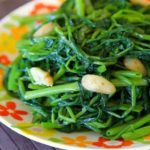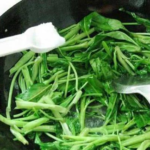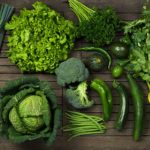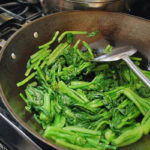Special stir-fried vegetables attract many people. Various types of vegetables such as morning glory, Chinese cabbage, green beans, pumpkin leaves, chayote, and water spinach when stir-fried without being green will look less appetizing, and usually, when non-green vegetables are eaten, they will taste bitter. To stir-fry a plate of fresh and delicious green vegetables, follow the following process and it will be as good as a hundred meals.
Prepare the vegetables to be completely dry
Vegetables that are wet with a lot of water when put into the pan for stir-frying will lower the heat of the pan, so the vegetables will turn dark. Therefore, you should wash and pat dry the vegetables. Especially if it is a type of vegetable that needs crispiness, stir-fried vegetables will only be crispy when the vegetables are dry, otherwise, the water from the vegetables will make them soft.
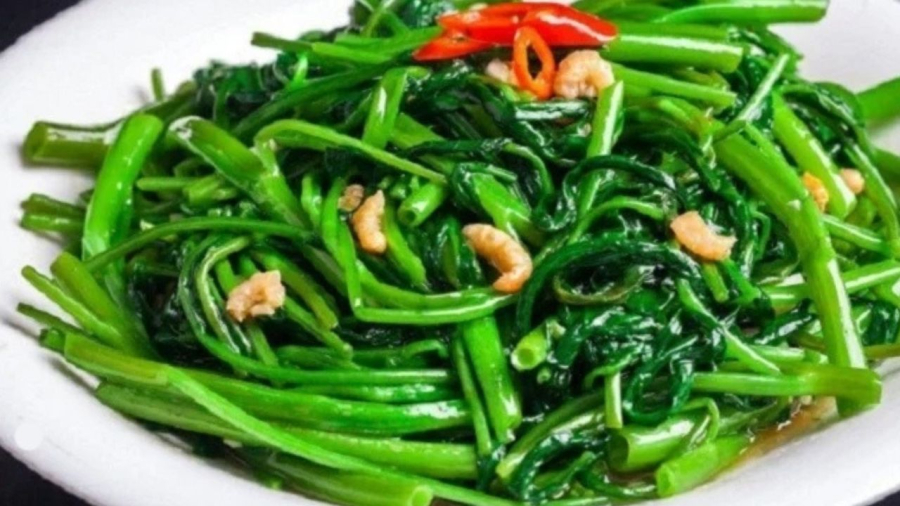
Prepare the stir-frying ingredients in advance
Seasonings such as garlic and shallots should be crushed in advance because when stir-frying, you need to pay attention to the timing, so if you chop the garlic while stir-frying, it will not be suitable and will make the vegetables turn red.
Sauce: If you use sauce for stir-fried vegetables, prepare a bowl to pour the sauce quickly when stir-frying.
Use high heat
When stir-frying, remember to preheat the pan and then turn on the stove to the highest heat setting. To determine if the pan is hot enough or not, drop 1-2 drops of water and if the water evaporates within 1 to 2 seconds after contact, the pan is hot and ready for stir-frying. Don’t make the pan too hot.
Pull the pan away from the highest heat level and then add oil. After that, lift the pan to evenly spread the oil on the surface of the pan. If you see smoke coming out when adding oil, it means the pan is too hot, so reduce the heat to cool it down a bit. Add garlic and shallots and stir them in the hot oil until fragrant. Use chopsticks or a spatula to push the garlic up into the pan and then add the vegetables. Add salt and MSG, stir quickly for about 2 minutes. Add sauce or clean water around the edges of the pan (Remember to pour around the edges of the pan, not in the middle, as pouring in the middle of the pan will cool the pan quickly, causing the vegetables to lose their green color). Then continue to stir to let the vegetables absorb the sauce. You can cover the pan but only for a short time, about 20 seconds, then uncover it and continue stir-frying until the vegetables are cooked. Avoid unevenly stir-frying the vegetables, otherwise, the areas that are not evenly heated will turn black.

That’s why each time you only stir-fry the right amount of vegetables compared to the pan so that they can transfer heat the best. Pay attention to the suitable stove for the pan. For example, an industrial gas stove can stir-fry a large pan, but a household stove can only stir-fry with a medium-sized pan. The phenomenon of small flames slowly cooking the vegetables will make them less crispy and turn dark, especially with morning glory. When stir-frying, remember to stir evenly and quickly so that the vegetables cook evenly and have even heat, they will not turn dark.
Some types of vegetables can be blanched before stir-frying, such as morning glory, because they have a lot of sap and will turn dark, so you can blanch them in salted boiling water, then remove them to drain, and then stir-fry.
stir-fried-vegetables-with-an-irresistible-crunch/’ title=’Master Chef’s Secret: The Key to Perfectly Stir-fried Vegetables with an Irresistible Crunch’>Master Chef’s Secret: The Key to Perfectly Stir-fried Vegetables with an Irresistible Crunch
Although it may seem like a simple dish to make, achieving a plate of perfectly cooked stir-fried vegetables that is vibrant, glossy, crispy, and not overly dark or mushy like those in restaurants requires some handy tips. Make sure to take note of these little tricks below to elevate your stir-frying game.

























